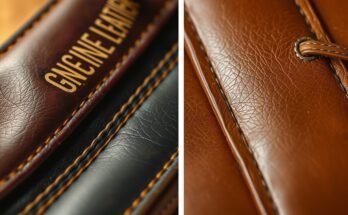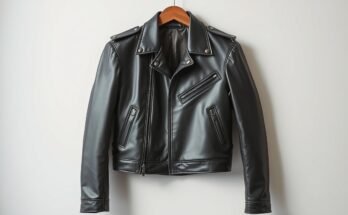Ever wondered if the headphones you wear, the car seats, or even your furniture are made from real leather or not? If you looked at the materials closely enough, you may have come across something called protein leather. Is it eco-friendly and how does it compare to real leather? We’re going to take a dive into protein leather, the material that looks and feels like real leather but doesn’t involve using any animal products. The synthetic leather replacement is durable, and affordable, but has its pros and cons.
What is Protein Leather, and Where Does It Come From?
It is vegan leather. It mimics the look and feel of real leather and is entirely man-made. It is made from a mix of protein and resin that is turned into flexible sheets that can be treated to look like natural leather. In addition, you might hear it being referred to as Pleather (short for plastic leather) because it combines bonding plastic and fabric base with embossing so that it appears like the grain and texture of genuine leather.
Even though it’s synthetic, protein leather is surprisingly strong and is a common material for car seats, headphone earpads and other objects you use every day. As such, it’s often a go-to product for manufacturers wishing to source vegan leather that remains strong for regular use.
Quality Grades: How Good is Protein Leather?
Like real leather, protein leather can come in different grades of quality from low to high. While lower grades may wear out, or people may feel stiffer, high quality protein leather can be used to closely mimic the durability of full grain leather.
Commonly used in car interiors and headphone cushions, higher quality protein leather has a fabric backing for added strength. One of its major advantages is that it is extra durable, and this makes it perfect for products that would continuously be handled or friction.
Protein Leather vs. Real Leather: How to Tell the Difference
It usually resembles real leather when it comes to looks, primarily because embossed patterns on top look so much like a natural leather grain. But there are subtle clues that reveal its artificial nature:
Touch: This leather, while similar in many respects, feels more uniform and smoother than real leather, and tends to have a more uniform feel in general.
Smell: It does not have the same real leather scent, but may smell slightly of an adhesive used during manufacturing.
Weight: Real leather has a heavier and also more substantial feel to it, while protein leather can be slightly lighter because of its synthetic base.
Functionality: Why Protein Leather is Perfect for Headphones and Car Seats

Protein leather is one of the most resilient and products in the market because of its ability to withstand wear and will last a long time. This makes it excellent for car seats, headphones, and furniture. It’s synthetic, and therefore it’s not as breathable as natural leather. In other words, while it’s perfect for long-lasting things, it may not be ideal for items of garments you’d shop for and wear directly on your skin.
It is too non-breathable to be suitable as outerwear, such as leather jackets due to the fact that it can heat up over time. Scratches resistance makes it a good choice for things that are going to have to be performed for a long time.
Pros of Protein Leather
Protein leather is no different from any other type of leather, with its own set of advantages. Here are some of the top benefits:
Vegan and Cruelty-Free: Protein leather is a guilt-free option for those avoiding animal products.
Cost-Effective: Compared to genuine leather, it’s much more affordable and can be used with a large number of products.
Durable: Protein leather is made up of a fabric backing and a plastic top layer, which enables it to experience a lot of wear and tear.
Water-Resistant: Since protein leather doesn’t absorb water as natural leather does, it is easier to maintain and clean.
Cons of Protein Leather
While it has many benefits, protein leather also has some downsides:
Lack of Breathability: Protein leather doesn’t breathe — and air doesn’t pass through it — so it can be uncomfortable in warm weather.
No Patina Development: Real leather gets better over time and develops a special patina. But protein leather doesn’t age the same way — it can get stiff over time.
Environmental Impact: Protein leather is not as eco-friendly as people generally think it would be. Plastic waste can be generated via the production process, so it isn’t as biodegradable as real leather.
How to Care for Protein Leather
Protein leather is a little tricky to care for because it doesn’t react to standard leather care products. Here are a few tips:
Use Synthetic-Safe Cleaners: Avoid real leather cleaners, as these may harm the synthetic surface, and search for cleaners made for faux leather or protein leather in particular.
DIY Cleaning Solutions: Regular cleaning will require you to use mild soap and water. Don’t use abrasive cleaners as that will wear down the finish.
Store Properly: When this leather is exposed to extreme heat or direct sunlight, it can crack and fade, so it’s best to avoid doing so.
Protein Leather in Headphones: A Popular Choice
The most popular use of protein leather is in headphones. It offers a comfortable, long wearing surface suitable for repeated use. This leather is very robust and ideal as headphones experience a whole lot of friction due to continuous use and removal. The reasons you see it in high-quality over-ear headphones from popular brands are its comfort and its resilience; it’s not as breathable, but it’s a classic in headphone construction.
Is Protein Leather Environmentally Friendly?
The eco-friendliness of this leather is a mixed bag. On the one hand, it’s a vegan option that doesn’t require anything animal-based; But making protein leather requires bonding plastic materials, which climatically creates plastic waste. Furthermore, unlike real leather, this leather is also less biodegradable, so its total environmental footprint is greater from start to end.
It’s better than many petroleum based synthetic leathers, but certainly not as eco-friendly as plant-based or recycled options. This, however, is still a more ethical option for people that are wanting to stay away from animal products when it comes to daily items.
Protein Leather vs. Faux Leather: What’s the Difference?
The only difference between protein leather and faux leather is they’re both fake leather made to replicate real leather. However, there are some key differences:
Composition: Along with synthetic materials, it is made from a mix of protein powder while faux leather is usually mostly synthetic.
Durability: Faux leather tends to be less durable than protein leather, which may be backed in fabric.
Feel and Look: Faux leather is more artificial looking (and feeling), but protein leather is designed to look and feel more like genuine leather, with embossing for texture.
Final Thoughts: Is Protein Leather Right for You?
If you’re looking for an affordable, durable and vegan choice in place of real leather then protein leather is a very interesting choice. Its synthetic composition makes it a tough, long lasting material that’s well suited to items subjected to frequent use: car seats, headphone earpads, etc. But it isn’t without its challenges. One of the major drawbacks is that it is neither breathable and nor environmental friendly.
If anyone is looking for something similar to leather but not anything with animal products they may like protein leather. But protein leather may come up a bit short in terms of natural beauty and long term aging. In the end, it comes down to what you want, at what cost, and what looks good.




